Analyzing Coles: Strategic Management in Australian Supermarket
VerifiedAdded on 2023/05/30
|14
|3337
|66
Report
AI Summary
This report provides a comprehensive strategic analysis of Coles Supermarkets within the Australian retail industry. It begins with a macro-environmental analysis using the PEST framework, followed by an industry analysis employing Porter's Five Forces to assess industry attractiveness. The report then delves into a company analysis, examining Coles' resources, capabilities, and core competencies using the VRIO framework. Competitor analysis identifies Woolworths as a primary competitive threat. The report concludes with recommendations for Coles, predicting the future of the company and the industry, highlighting the moderate environment for Coles and the potential for growth through effective strategies and marketing techniques. Desklib provides this and many other solved assignments for students.
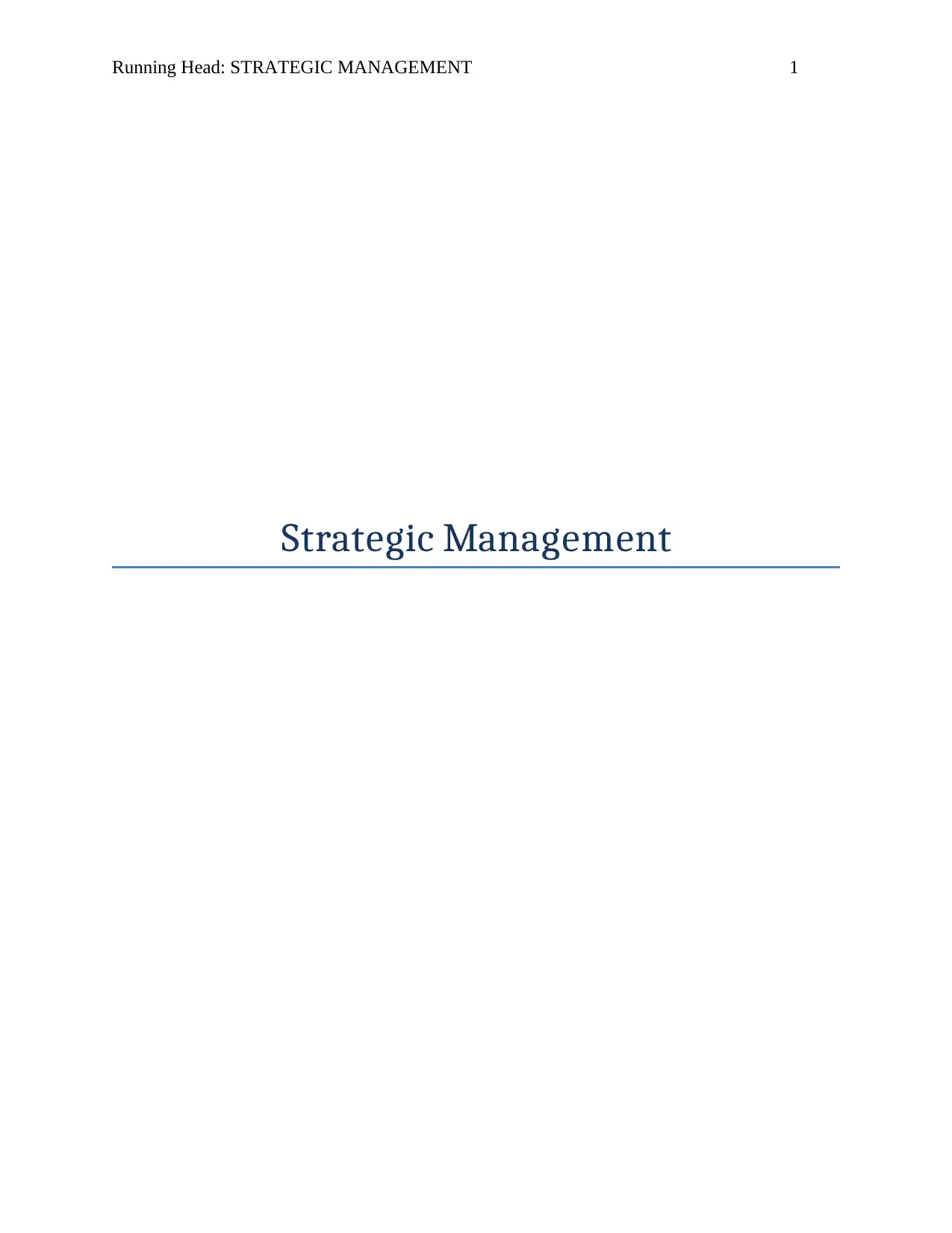
Running Head: STRATEGIC MANAGEMENT 1
Strategic Management
Strategic Management
Paraphrase This Document
Need a fresh take? Get an instant paraphrase of this document with our AI Paraphraser
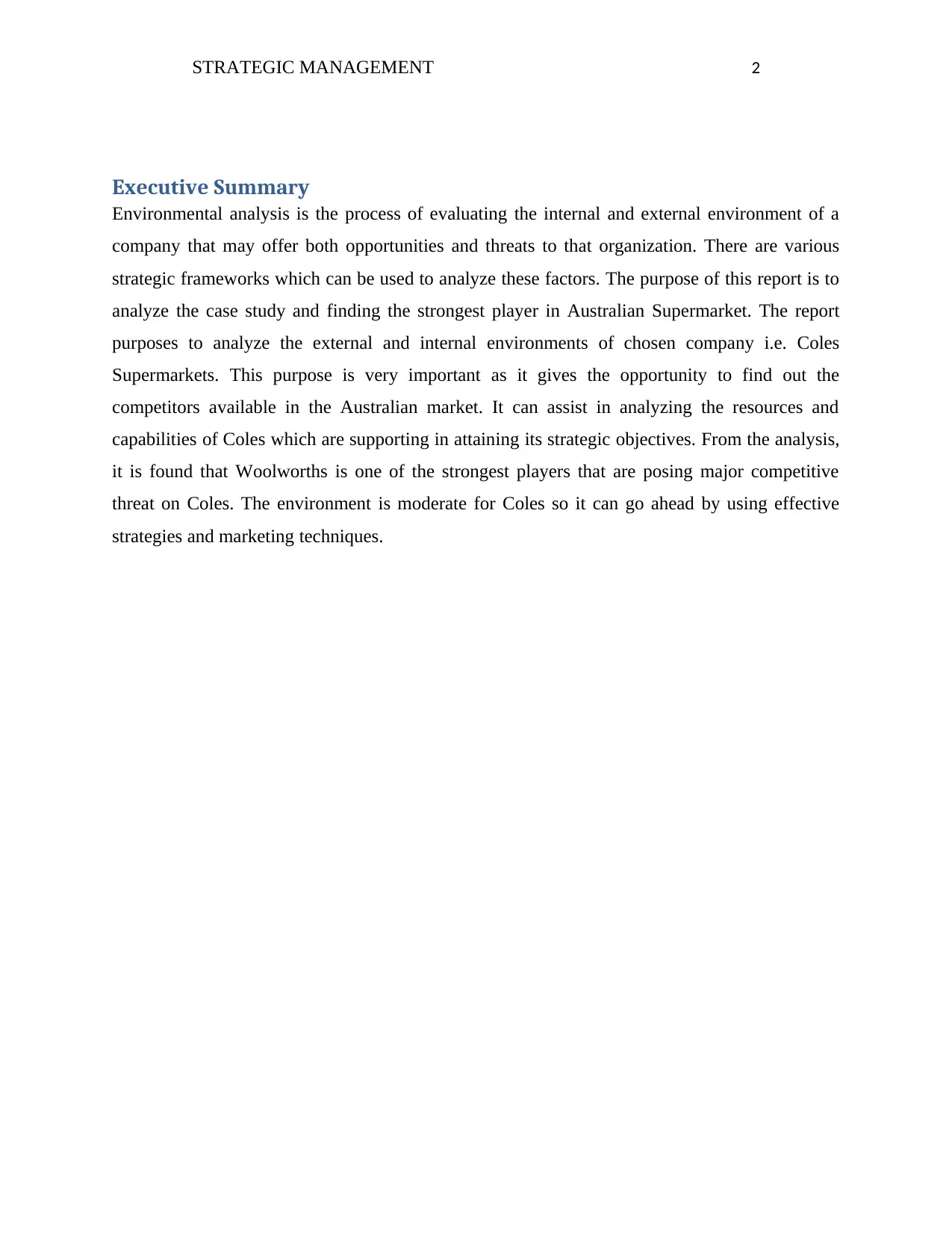
STRATEGIC MANAGEMENT 2
Executive Summary
Environmental analysis is the process of evaluating the internal and external environment of a
company that may offer both opportunities and threats to that organization. There are various
strategic frameworks which can be used to analyze these factors. The purpose of this report is to
analyze the case study and finding the strongest player in Australian Supermarket. The report
purposes to analyze the external and internal environments of chosen company i.e. Coles
Supermarkets. This purpose is very important as it gives the opportunity to find out the
competitors available in the Australian market. It can assist in analyzing the resources and
capabilities of Coles which are supporting in attaining its strategic objectives. From the analysis,
it is found that Woolworths is one of the strongest players that are posing major competitive
threat on Coles. The environment is moderate for Coles so it can go ahead by using effective
strategies and marketing techniques.
Executive Summary
Environmental analysis is the process of evaluating the internal and external environment of a
company that may offer both opportunities and threats to that organization. There are various
strategic frameworks which can be used to analyze these factors. The purpose of this report is to
analyze the case study and finding the strongest player in Australian Supermarket. The report
purposes to analyze the external and internal environments of chosen company i.e. Coles
Supermarkets. This purpose is very important as it gives the opportunity to find out the
competitors available in the Australian market. It can assist in analyzing the resources and
capabilities of Coles which are supporting in attaining its strategic objectives. From the analysis,
it is found that Woolworths is one of the strongest players that are posing major competitive
threat on Coles. The environment is moderate for Coles so it can go ahead by using effective
strategies and marketing techniques.
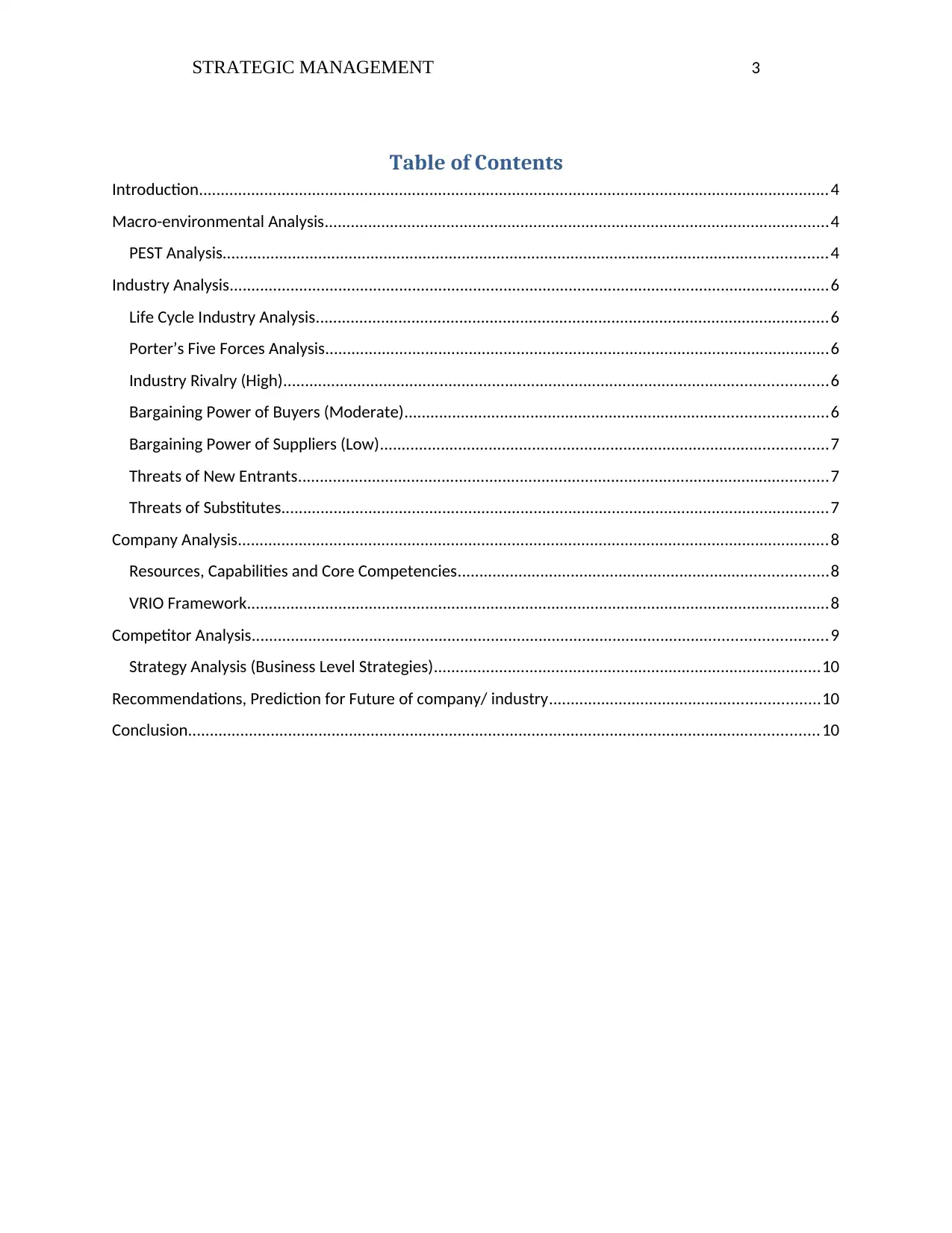
STRATEGIC MANAGEMENT 3
Table of Contents
Introduction.................................................................................................................................................4
Macro-environmental Analysis....................................................................................................................4
PEST Analysis...........................................................................................................................................4
Industry Analysis..........................................................................................................................................6
Life Cycle Industry Analysis......................................................................................................................6
Porter’s Five Forces Analysis....................................................................................................................6
Industry Rivalry (High).............................................................................................................................6
Bargaining Power of Buyers (Moderate).................................................................................................6
Bargaining Power of Suppliers (Low).......................................................................................................7
Threats of New Entrants..........................................................................................................................7
Threats of Substitutes..............................................................................................................................7
Company Analysis........................................................................................................................................8
Resources, Capabilities and Core Competencies.....................................................................................8
VRIO Framework......................................................................................................................................8
Competitor Analysis....................................................................................................................................9
Strategy Analysis (Business Level Strategies).........................................................................................10
Recommendations, Prediction for Future of company/ industry..............................................................10
Conclusion.................................................................................................................................................10
Table of Contents
Introduction.................................................................................................................................................4
Macro-environmental Analysis....................................................................................................................4
PEST Analysis...........................................................................................................................................4
Industry Analysis..........................................................................................................................................6
Life Cycle Industry Analysis......................................................................................................................6
Porter’s Five Forces Analysis....................................................................................................................6
Industry Rivalry (High).............................................................................................................................6
Bargaining Power of Buyers (Moderate).................................................................................................6
Bargaining Power of Suppliers (Low).......................................................................................................7
Threats of New Entrants..........................................................................................................................7
Threats of Substitutes..............................................................................................................................7
Company Analysis........................................................................................................................................8
Resources, Capabilities and Core Competencies.....................................................................................8
VRIO Framework......................................................................................................................................8
Competitor Analysis....................................................................................................................................9
Strategy Analysis (Business Level Strategies).........................................................................................10
Recommendations, Prediction for Future of company/ industry..............................................................10
Conclusion.................................................................................................................................................10
⊘ This is a preview!⊘
Do you want full access?
Subscribe today to unlock all pages.

Trusted by 1+ million students worldwide
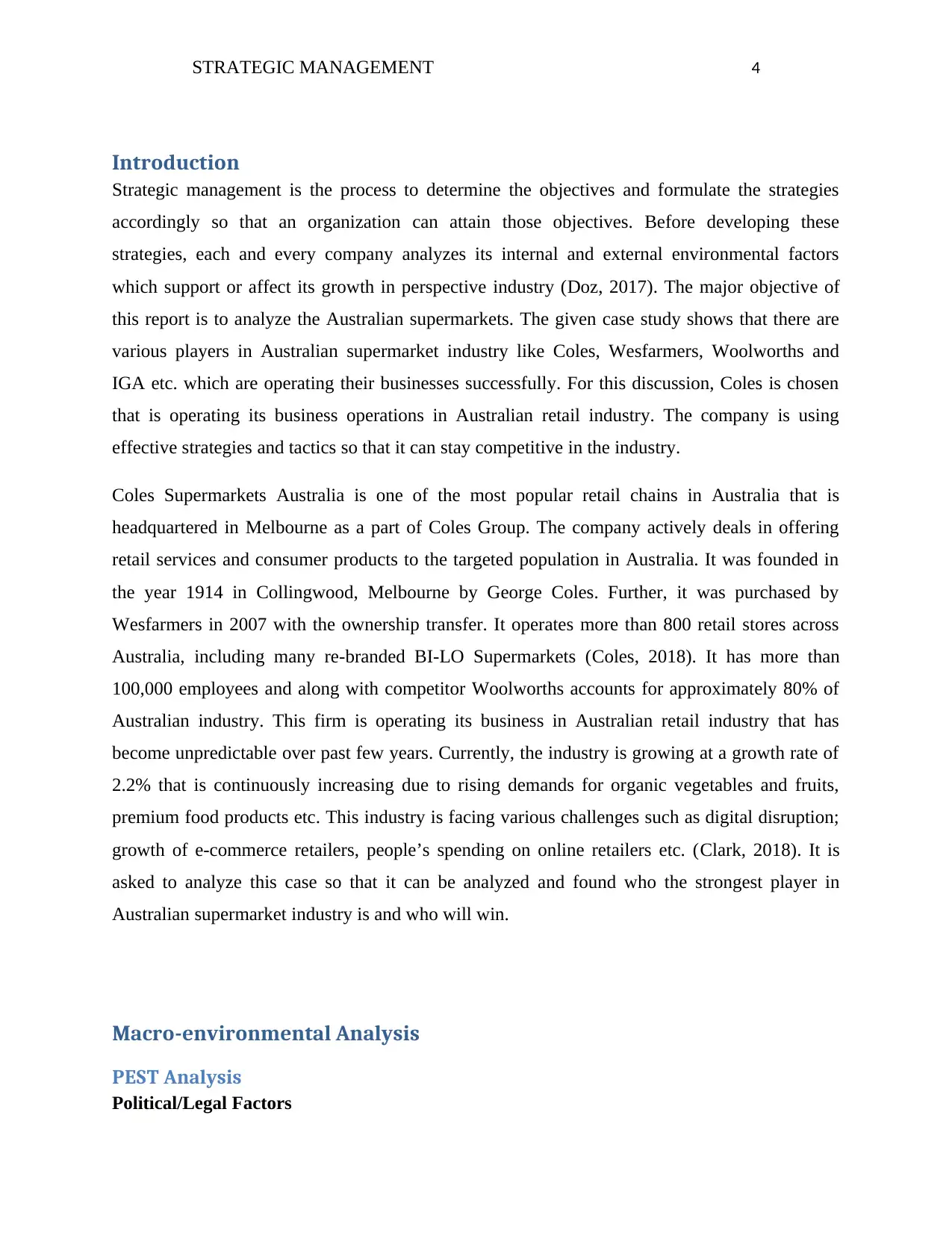
STRATEGIC MANAGEMENT 4
Introduction
Strategic management is the process to determine the objectives and formulate the strategies
accordingly so that an organization can attain those objectives. Before developing these
strategies, each and every company analyzes its internal and external environmental factors
which support or affect its growth in perspective industry (Doz, 2017). The major objective of
this report is to analyze the Australian supermarkets. The given case study shows that there are
various players in Australian supermarket industry like Coles, Wesfarmers, Woolworths and
IGA etc. which are operating their businesses successfully. For this discussion, Coles is chosen
that is operating its business operations in Australian retail industry. The company is using
effective strategies and tactics so that it can stay competitive in the industry.
Coles Supermarkets Australia is one of the most popular retail chains in Australia that is
headquartered in Melbourne as a part of Coles Group. The company actively deals in offering
retail services and consumer products to the targeted population in Australia. It was founded in
the year 1914 in Collingwood, Melbourne by George Coles. Further, it was purchased by
Wesfarmers in 2007 with the ownership transfer. It operates more than 800 retail stores across
Australia, including many re-branded BI-LO Supermarkets (Coles, 2018). It has more than
100,000 employees and along with competitor Woolworths accounts for approximately 80% of
Australian industry. This firm is operating its business in Australian retail industry that has
become unpredictable over past few years. Currently, the industry is growing at a growth rate of
2.2% that is continuously increasing due to rising demands for organic vegetables and fruits,
premium food products etc. This industry is facing various challenges such as digital disruption;
growth of e-commerce retailers, people’s spending on online retailers etc. (Clark, 2018). It is
asked to analyze this case so that it can be analyzed and found who the strongest player in
Australian supermarket industry is and who will win.
Macro-environmental Analysis
PEST Analysis
Political/Legal Factors
Introduction
Strategic management is the process to determine the objectives and formulate the strategies
accordingly so that an organization can attain those objectives. Before developing these
strategies, each and every company analyzes its internal and external environmental factors
which support or affect its growth in perspective industry (Doz, 2017). The major objective of
this report is to analyze the Australian supermarkets. The given case study shows that there are
various players in Australian supermarket industry like Coles, Wesfarmers, Woolworths and
IGA etc. which are operating their businesses successfully. For this discussion, Coles is chosen
that is operating its business operations in Australian retail industry. The company is using
effective strategies and tactics so that it can stay competitive in the industry.
Coles Supermarkets Australia is one of the most popular retail chains in Australia that is
headquartered in Melbourne as a part of Coles Group. The company actively deals in offering
retail services and consumer products to the targeted population in Australia. It was founded in
the year 1914 in Collingwood, Melbourne by George Coles. Further, it was purchased by
Wesfarmers in 2007 with the ownership transfer. It operates more than 800 retail stores across
Australia, including many re-branded BI-LO Supermarkets (Coles, 2018). It has more than
100,000 employees and along with competitor Woolworths accounts for approximately 80% of
Australian industry. This firm is operating its business in Australian retail industry that has
become unpredictable over past few years. Currently, the industry is growing at a growth rate of
2.2% that is continuously increasing due to rising demands for organic vegetables and fruits,
premium food products etc. This industry is facing various challenges such as digital disruption;
growth of e-commerce retailers, people’s spending on online retailers etc. (Clark, 2018). It is
asked to analyze this case so that it can be analyzed and found who the strongest player in
Australian supermarket industry is and who will win.
Macro-environmental Analysis
PEST Analysis
Political/Legal Factors
Paraphrase This Document
Need a fresh take? Get an instant paraphrase of this document with our AI Paraphraser
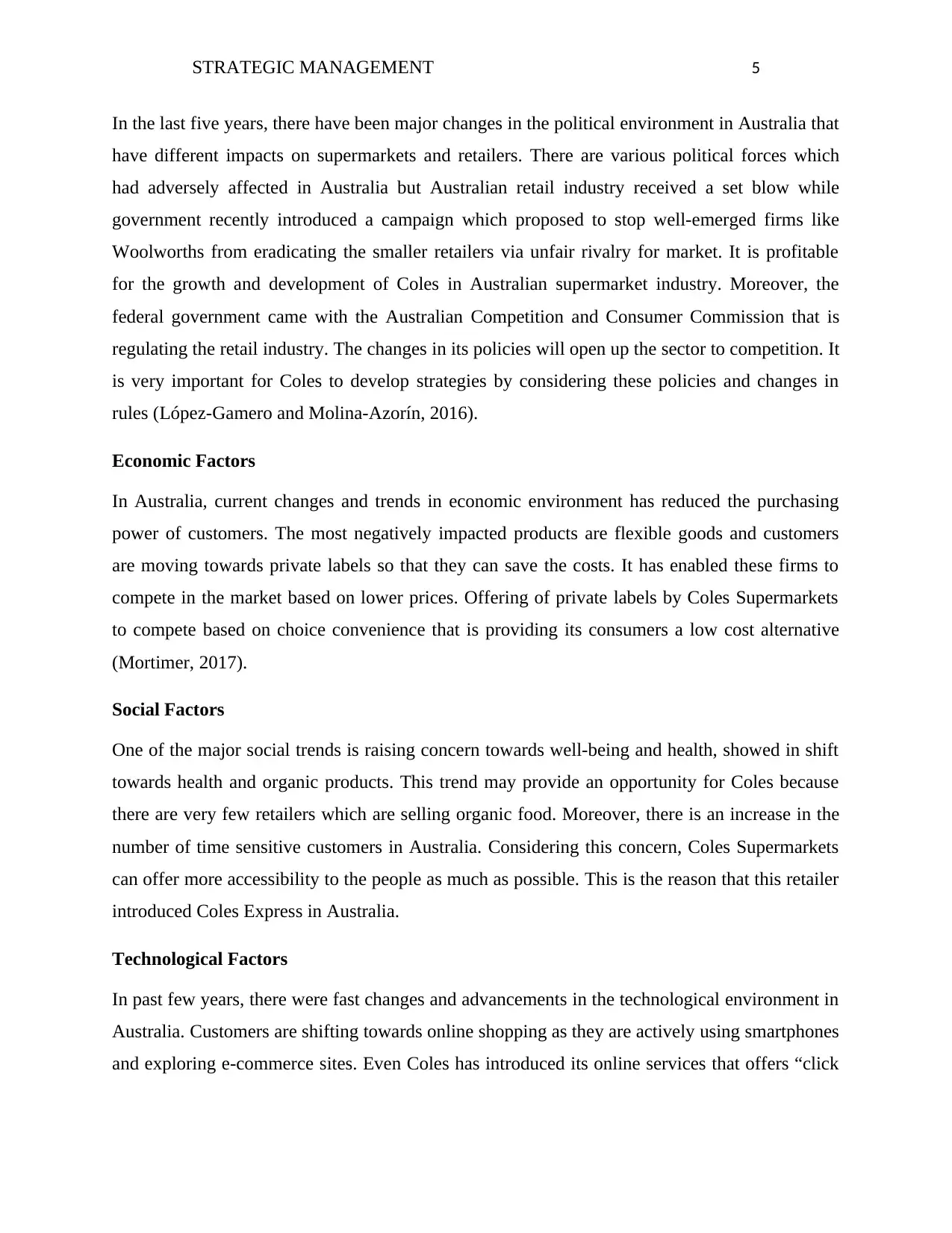
STRATEGIC MANAGEMENT 5
In the last five years, there have been major changes in the political environment in Australia that
have different impacts on supermarkets and retailers. There are various political forces which
had adversely affected in Australia but Australian retail industry received a set blow while
government recently introduced a campaign which proposed to stop well-emerged firms like
Woolworths from eradicating the smaller retailers via unfair rivalry for market. It is profitable
for the growth and development of Coles in Australian supermarket industry. Moreover, the
federal government came with the Australian Competition and Consumer Commission that is
regulating the retail industry. The changes in its policies will open up the sector to competition. It
is very important for Coles to develop strategies by considering these policies and changes in
rules (López-Gamero and Molina-Azorín, 2016).
Economic Factors
In Australia, current changes and trends in economic environment has reduced the purchasing
power of customers. The most negatively impacted products are flexible goods and customers
are moving towards private labels so that they can save the costs. It has enabled these firms to
compete in the market based on lower prices. Offering of private labels by Coles Supermarkets
to compete based on choice convenience that is providing its consumers a low cost alternative
(Mortimer, 2017).
Social Factors
One of the major social trends is raising concern towards well-being and health, showed in shift
towards health and organic products. This trend may provide an opportunity for Coles because
there are very few retailers which are selling organic food. Moreover, there is an increase in the
number of time sensitive customers in Australia. Considering this concern, Coles Supermarkets
can offer more accessibility to the people as much as possible. This is the reason that this retailer
introduced Coles Express in Australia.
Technological Factors
In past few years, there were fast changes and advancements in the technological environment in
Australia. Customers are shifting towards online shopping as they are actively using smartphones
and exploring e-commerce sites. Even Coles has introduced its online services that offers “click
In the last five years, there have been major changes in the political environment in Australia that
have different impacts on supermarkets and retailers. There are various political forces which
had adversely affected in Australia but Australian retail industry received a set blow while
government recently introduced a campaign which proposed to stop well-emerged firms like
Woolworths from eradicating the smaller retailers via unfair rivalry for market. It is profitable
for the growth and development of Coles in Australian supermarket industry. Moreover, the
federal government came with the Australian Competition and Consumer Commission that is
regulating the retail industry. The changes in its policies will open up the sector to competition. It
is very important for Coles to develop strategies by considering these policies and changes in
rules (López-Gamero and Molina-Azorín, 2016).
Economic Factors
In Australia, current changes and trends in economic environment has reduced the purchasing
power of customers. The most negatively impacted products are flexible goods and customers
are moving towards private labels so that they can save the costs. It has enabled these firms to
compete in the market based on lower prices. Offering of private labels by Coles Supermarkets
to compete based on choice convenience that is providing its consumers a low cost alternative
(Mortimer, 2017).
Social Factors
One of the major social trends is raising concern towards well-being and health, showed in shift
towards health and organic products. This trend may provide an opportunity for Coles because
there are very few retailers which are selling organic food. Moreover, there is an increase in the
number of time sensitive customers in Australia. Considering this concern, Coles Supermarkets
can offer more accessibility to the people as much as possible. This is the reason that this retailer
introduced Coles Express in Australia.
Technological Factors
In past few years, there were fast changes and advancements in the technological environment in
Australia. Customers are shifting towards online shopping as they are actively using smartphones
and exploring e-commerce sites. Even Coles has introduced its online services that offers “click
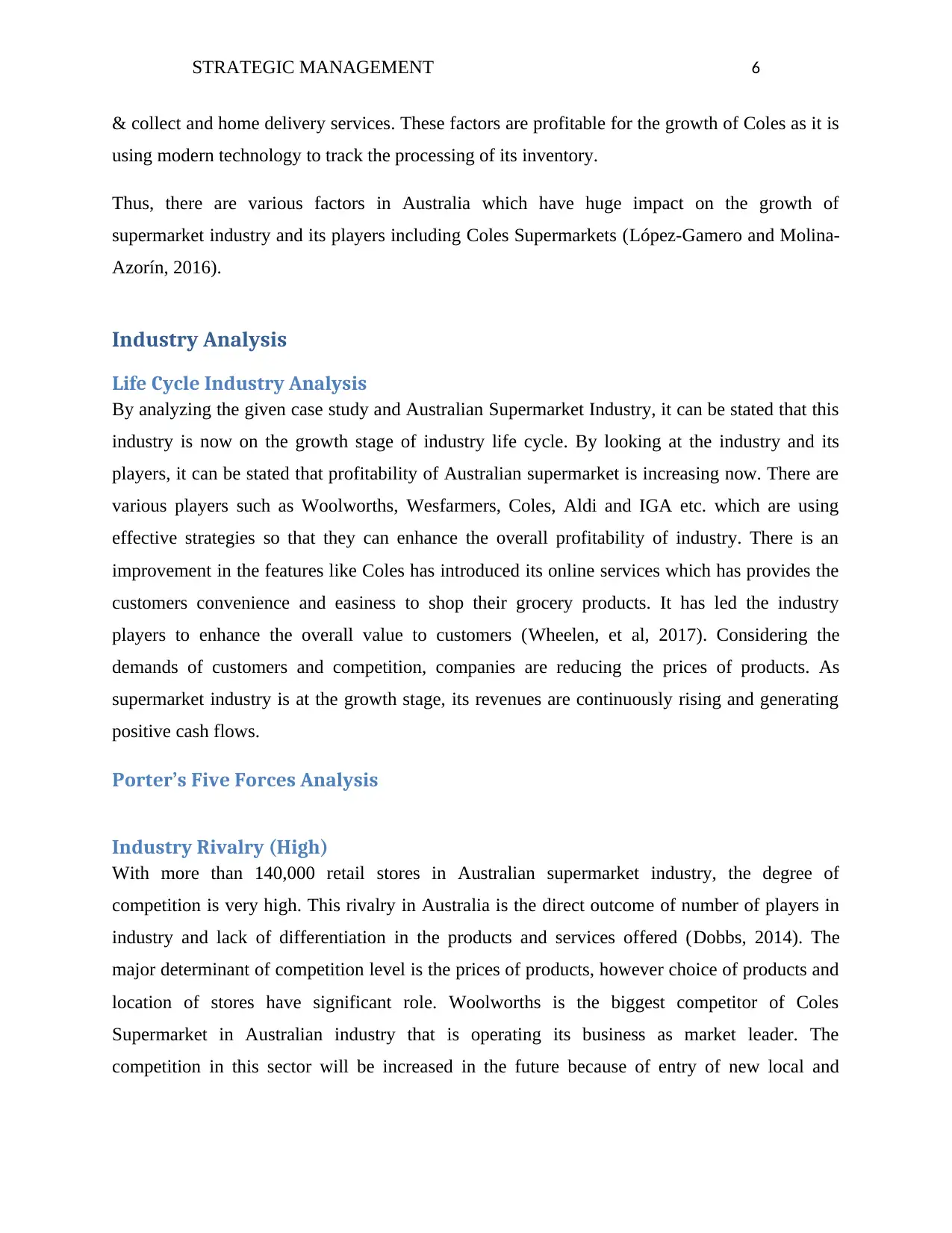
STRATEGIC MANAGEMENT 6
& collect and home delivery services. These factors are profitable for the growth of Coles as it is
using modern technology to track the processing of its inventory.
Thus, there are various factors in Australia which have huge impact on the growth of
supermarket industry and its players including Coles Supermarkets (López-Gamero and Molina-
Azorín, 2016).
Industry Analysis
Life Cycle Industry Analysis
By analyzing the given case study and Australian Supermarket Industry, it can be stated that this
industry is now on the growth stage of industry life cycle. By looking at the industry and its
players, it can be stated that profitability of Australian supermarket is increasing now. There are
various players such as Woolworths, Wesfarmers, Coles, Aldi and IGA etc. which are using
effective strategies so that they can enhance the overall profitability of industry. There is an
improvement in the features like Coles has introduced its online services which has provides the
customers convenience and easiness to shop their grocery products. It has led the industry
players to enhance the overall value to customers (Wheelen, et al, 2017). Considering the
demands of customers and competition, companies are reducing the prices of products. As
supermarket industry is at the growth stage, its revenues are continuously rising and generating
positive cash flows.
Porter’s Five Forces Analysis
Industry Rivalry (High)
With more than 140,000 retail stores in Australian supermarket industry, the degree of
competition is very high. This rivalry in Australia is the direct outcome of number of players in
industry and lack of differentiation in the products and services offered (Dobbs, 2014). The
major determinant of competition level is the prices of products, however choice of products and
location of stores have significant role. Woolworths is the biggest competitor of Coles
Supermarket in Australian industry that is operating its business as market leader. The
competition in this sector will be increased in the future because of entry of new local and
& collect and home delivery services. These factors are profitable for the growth of Coles as it is
using modern technology to track the processing of its inventory.
Thus, there are various factors in Australia which have huge impact on the growth of
supermarket industry and its players including Coles Supermarkets (López-Gamero and Molina-
Azorín, 2016).
Industry Analysis
Life Cycle Industry Analysis
By analyzing the given case study and Australian Supermarket Industry, it can be stated that this
industry is now on the growth stage of industry life cycle. By looking at the industry and its
players, it can be stated that profitability of Australian supermarket is increasing now. There are
various players such as Woolworths, Wesfarmers, Coles, Aldi and IGA etc. which are using
effective strategies so that they can enhance the overall profitability of industry. There is an
improvement in the features like Coles has introduced its online services which has provides the
customers convenience and easiness to shop their grocery products. It has led the industry
players to enhance the overall value to customers (Wheelen, et al, 2017). Considering the
demands of customers and competition, companies are reducing the prices of products. As
supermarket industry is at the growth stage, its revenues are continuously rising and generating
positive cash flows.
Porter’s Five Forces Analysis
Industry Rivalry (High)
With more than 140,000 retail stores in Australian supermarket industry, the degree of
competition is very high. This rivalry in Australia is the direct outcome of number of players in
industry and lack of differentiation in the products and services offered (Dobbs, 2014). The
major determinant of competition level is the prices of products, however choice of products and
location of stores have significant role. Woolworths is the biggest competitor of Coles
Supermarket in Australian industry that is operating its business as market leader. The
competition in this sector will be increased in the future because of entry of new local and
⊘ This is a preview!⊘
Do you want full access?
Subscribe today to unlock all pages.

Trusted by 1+ million students worldwide
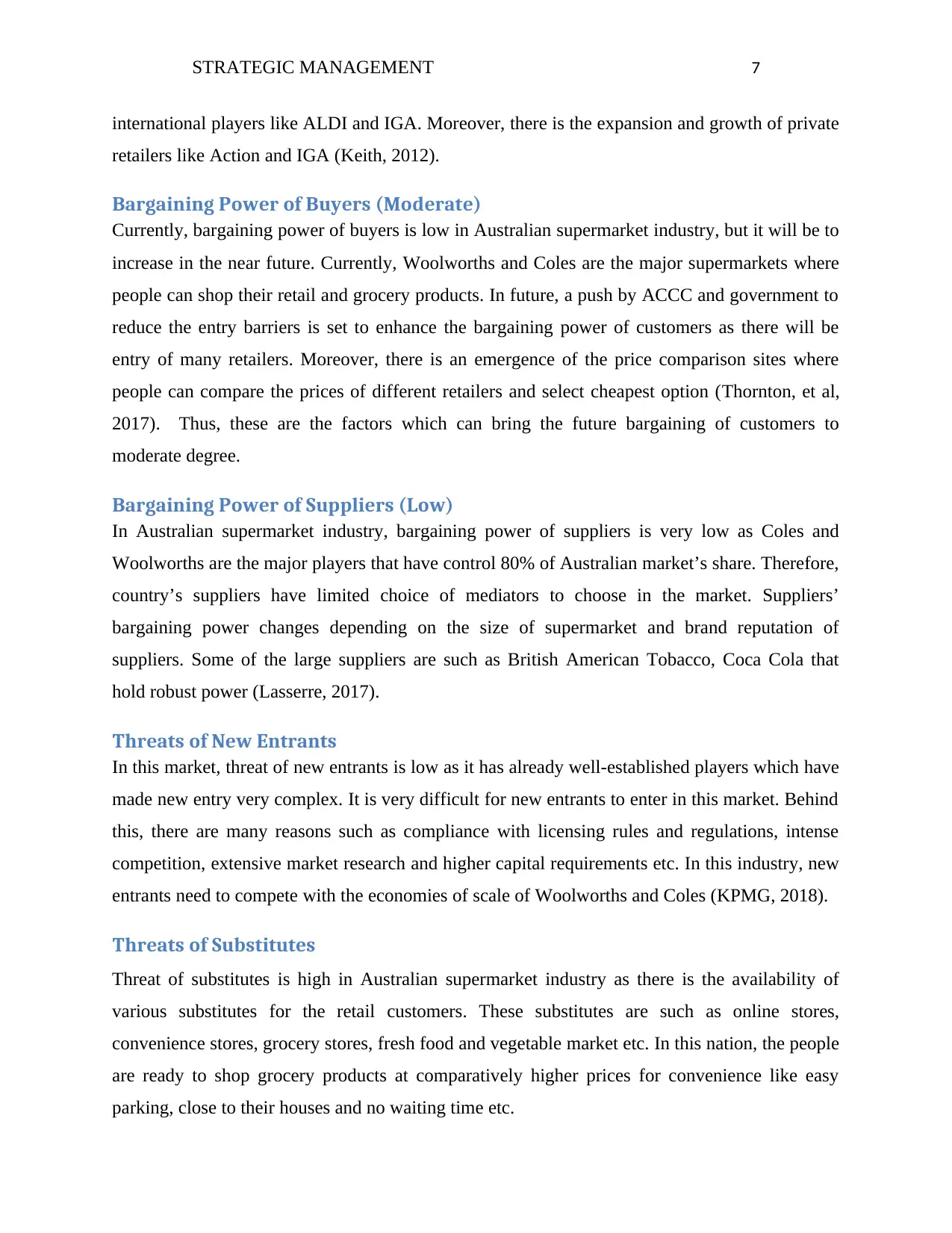
STRATEGIC MANAGEMENT 7
international players like ALDI and IGA. Moreover, there is the expansion and growth of private
retailers like Action and IGA (Keith, 2012).
Bargaining Power of Buyers (Moderate)
Currently, bargaining power of buyers is low in Australian supermarket industry, but it will be to
increase in the near future. Currently, Woolworths and Coles are the major supermarkets where
people can shop their retail and grocery products. In future, a push by ACCC and government to
reduce the entry barriers is set to enhance the bargaining power of customers as there will be
entry of many retailers. Moreover, there is an emergence of the price comparison sites where
people can compare the prices of different retailers and select cheapest option (Thornton, et al,
2017). Thus, these are the factors which can bring the future bargaining of customers to
moderate degree.
Bargaining Power of Suppliers (Low)
In Australian supermarket industry, bargaining power of suppliers is very low as Coles and
Woolworths are the major players that have control 80% of Australian market’s share. Therefore,
country’s suppliers have limited choice of mediators to choose in the market. Suppliers’
bargaining power changes depending on the size of supermarket and brand reputation of
suppliers. Some of the large suppliers are such as British American Tobacco, Coca Cola that
hold robust power (Lasserre, 2017).
Threats of New Entrants
In this market, threat of new entrants is low as it has already well-established players which have
made new entry very complex. It is very difficult for new entrants to enter in this market. Behind
this, there are many reasons such as compliance with licensing rules and regulations, intense
competition, extensive market research and higher capital requirements etc. In this industry, new
entrants need to compete with the economies of scale of Woolworths and Coles (KPMG, 2018).
Threats of Substitutes
Threat of substitutes is high in Australian supermarket industry as there is the availability of
various substitutes for the retail customers. These substitutes are such as online stores,
convenience stores, grocery stores, fresh food and vegetable market etc. In this nation, the people
are ready to shop grocery products at comparatively higher prices for convenience like easy
parking, close to their houses and no waiting time etc.
international players like ALDI and IGA. Moreover, there is the expansion and growth of private
retailers like Action and IGA (Keith, 2012).
Bargaining Power of Buyers (Moderate)
Currently, bargaining power of buyers is low in Australian supermarket industry, but it will be to
increase in the near future. Currently, Woolworths and Coles are the major supermarkets where
people can shop their retail and grocery products. In future, a push by ACCC and government to
reduce the entry barriers is set to enhance the bargaining power of customers as there will be
entry of many retailers. Moreover, there is an emergence of the price comparison sites where
people can compare the prices of different retailers and select cheapest option (Thornton, et al,
2017). Thus, these are the factors which can bring the future bargaining of customers to
moderate degree.
Bargaining Power of Suppliers (Low)
In Australian supermarket industry, bargaining power of suppliers is very low as Coles and
Woolworths are the major players that have control 80% of Australian market’s share. Therefore,
country’s suppliers have limited choice of mediators to choose in the market. Suppliers’
bargaining power changes depending on the size of supermarket and brand reputation of
suppliers. Some of the large suppliers are such as British American Tobacco, Coca Cola that
hold robust power (Lasserre, 2017).
Threats of New Entrants
In this market, threat of new entrants is low as it has already well-established players which have
made new entry very complex. It is very difficult for new entrants to enter in this market. Behind
this, there are many reasons such as compliance with licensing rules and regulations, intense
competition, extensive market research and higher capital requirements etc. In this industry, new
entrants need to compete with the economies of scale of Woolworths and Coles (KPMG, 2018).
Threats of Substitutes
Threat of substitutes is high in Australian supermarket industry as there is the availability of
various substitutes for the retail customers. These substitutes are such as online stores,
convenience stores, grocery stores, fresh food and vegetable market etc. In this nation, the people
are ready to shop grocery products at comparatively higher prices for convenience like easy
parking, close to their houses and no waiting time etc.
Paraphrase This Document
Need a fresh take? Get an instant paraphrase of this document with our AI Paraphraser

STRATEGIC MANAGEMENT 8
Thus, the above Porter’s five forces have concluded the industry attractiveness for Coles
Supermarkets. Recently, the attractiveness of industry for Coles is moderately high in the sector.
The main reason behind this is the higher entry barriers in this market and moderate bargaining
power of customers (Cooper, 2018). It can be seen by looking at the increased profitability of
Coles in Australian Supermarket industry.
Company Analysis
Resources, Capabilities and Core Competencies
Effective Supply Chain
Efficient supply chain of Coles is both a capability and resource in its outbound and inbound
logistics. The considerable cost saving offered by supply chain allows Coles to compete with
Woolworths (Chan, Ngai and Moon, 2017). The extent of this competency is important for
management and implementation of strategies.
Effective Senior Management
Even there will increase in the recession and rate of inflation but still Coles has attained a
significant growth. It has made a great contribution to the senior management of Coles. Its senior
management is an important resource which is allowing it to compete with other competing firms
in Australian retail market.
Brand Image
The brand image of Coles has been developed over various decades and it was attained via
positive experiences of customers. It can be attributed to the rigid quality evaluation which exists
in the organization (Rothaermel, 2015).
VRIO Framework
VRIO analysis of Coles Supermarkets is conducted below:
Resources Valuable Rare Imitable Organization Advantage
Brand Image Yes Yes No Yes Sustainable
Thus, the above Porter’s five forces have concluded the industry attractiveness for Coles
Supermarkets. Recently, the attractiveness of industry for Coles is moderately high in the sector.
The main reason behind this is the higher entry barriers in this market and moderate bargaining
power of customers (Cooper, 2018). It can be seen by looking at the increased profitability of
Coles in Australian Supermarket industry.
Company Analysis
Resources, Capabilities and Core Competencies
Effective Supply Chain
Efficient supply chain of Coles is both a capability and resource in its outbound and inbound
logistics. The considerable cost saving offered by supply chain allows Coles to compete with
Woolworths (Chan, Ngai and Moon, 2017). The extent of this competency is important for
management and implementation of strategies.
Effective Senior Management
Even there will increase in the recession and rate of inflation but still Coles has attained a
significant growth. It has made a great contribution to the senior management of Coles. Its senior
management is an important resource which is allowing it to compete with other competing firms
in Australian retail market.
Brand Image
The brand image of Coles has been developed over various decades and it was attained via
positive experiences of customers. It can be attributed to the rigid quality evaluation which exists
in the organization (Rothaermel, 2015).
VRIO Framework
VRIO analysis of Coles Supermarkets is conducted below:
Resources Valuable Rare Imitable Organization Advantage
Brand Image Yes Yes No Yes Sustainable

STRATEGIC MANAGEMENT 9
Technological
Capability Yes Yes No Yes Temporary
Quality Yes Yes No Yes Sustainable
Qualified Team Yes Yes No Yes Sustainable
Cost effectiveness Yes Yes Yes Yes Sustainable
Efficient Supply
Chain Yes No Yes Yes Permanent
Senior Management Yes No Yes Yes Sustainable
Valuable
The brand image of Coles is valuable as it provides substantial differentiation from competing
brands and contributes to the higher satisfaction level of customers. However, competitors also
have the potential to offer higher quality products. So, this is not a distinctive competitive edge
for Coles.
Rare
At Coles, all the various resources and capabilities are rare expect senior management and
efficient supply chain process. Top management cannot be considered rare as many of the
companies have the potential to establish a capable top management (Knott, 2015).
Imitable
Coles owns various resources and capabilities which cannot be copied by other firms in
Australian supermarket industry. Technological innovation is one of the most significant
resources that other players cannot imitate. It is very important for the company to ensure that it
uses exclusiveness in its resources and capabilities.
Organized
It indicates that the company has managed its resources and capabilities in an effective way so
that it is able to deal with the competitive threats and other external factors.
Technological
Capability Yes Yes No Yes Temporary
Quality Yes Yes No Yes Sustainable
Qualified Team Yes Yes No Yes Sustainable
Cost effectiveness Yes Yes Yes Yes Sustainable
Efficient Supply
Chain Yes No Yes Yes Permanent
Senior Management Yes No Yes Yes Sustainable
Valuable
The brand image of Coles is valuable as it provides substantial differentiation from competing
brands and contributes to the higher satisfaction level of customers. However, competitors also
have the potential to offer higher quality products. So, this is not a distinctive competitive edge
for Coles.
Rare
At Coles, all the various resources and capabilities are rare expect senior management and
efficient supply chain process. Top management cannot be considered rare as many of the
companies have the potential to establish a capable top management (Knott, 2015).
Imitable
Coles owns various resources and capabilities which cannot be copied by other firms in
Australian supermarket industry. Technological innovation is one of the most significant
resources that other players cannot imitate. It is very important for the company to ensure that it
uses exclusiveness in its resources and capabilities.
Organized
It indicates that the company has managed its resources and capabilities in an effective way so
that it is able to deal with the competitive threats and other external factors.
⊘ This is a preview!⊘
Do you want full access?
Subscribe today to unlock all pages.

Trusted by 1+ million students worldwide
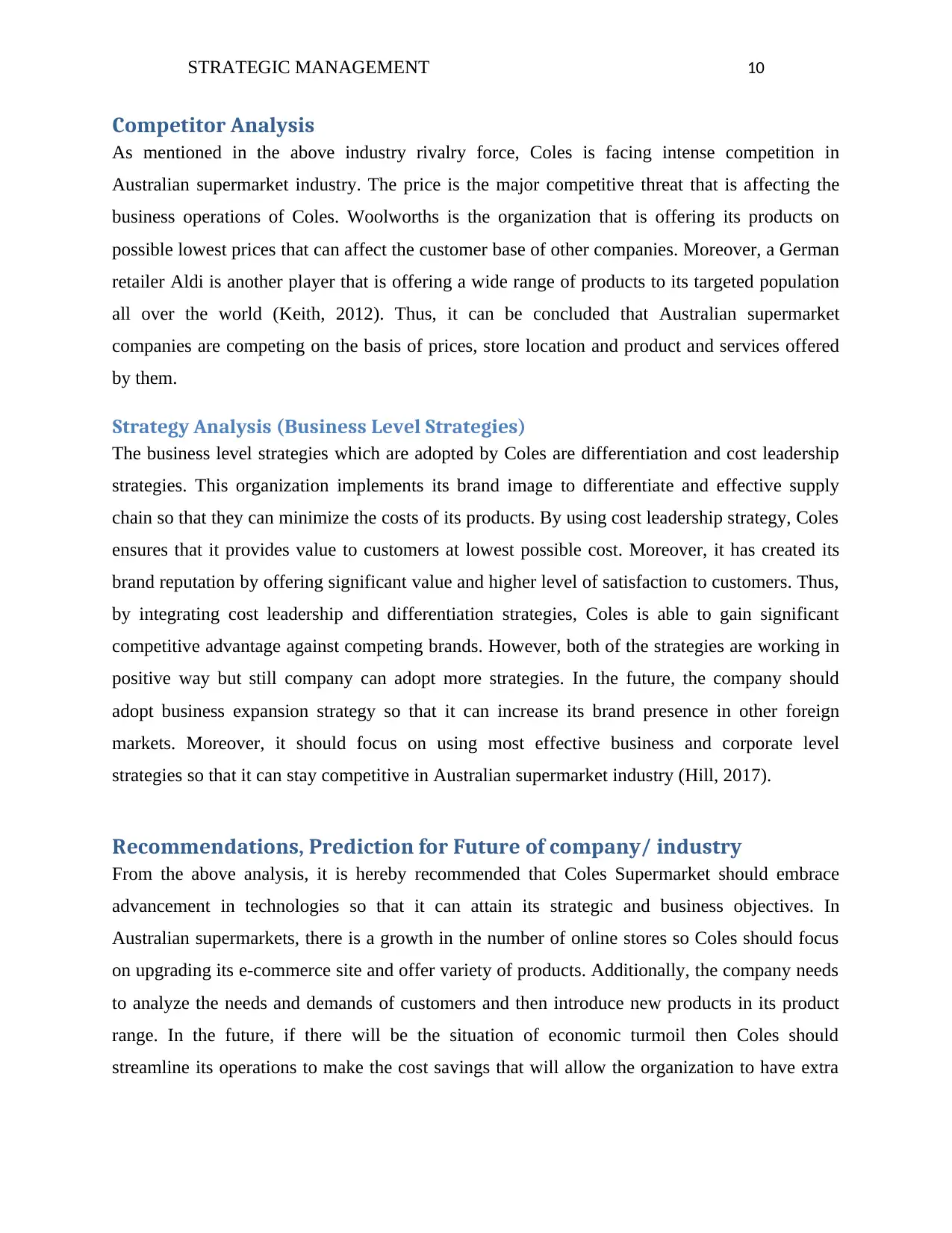
STRATEGIC MANAGEMENT 10
Competitor Analysis
As mentioned in the above industry rivalry force, Coles is facing intense competition in
Australian supermarket industry. The price is the major competitive threat that is affecting the
business operations of Coles. Woolworths is the organization that is offering its products on
possible lowest prices that can affect the customer base of other companies. Moreover, a German
retailer Aldi is another player that is offering a wide range of products to its targeted population
all over the world (Keith, 2012). Thus, it can be concluded that Australian supermarket
companies are competing on the basis of prices, store location and product and services offered
by them.
Strategy Analysis (Business Level Strategies)
The business level strategies which are adopted by Coles are differentiation and cost leadership
strategies. This organization implements its brand image to differentiate and effective supply
chain so that they can minimize the costs of its products. By using cost leadership strategy, Coles
ensures that it provides value to customers at lowest possible cost. Moreover, it has created its
brand reputation by offering significant value and higher level of satisfaction to customers. Thus,
by integrating cost leadership and differentiation strategies, Coles is able to gain significant
competitive advantage against competing brands. However, both of the strategies are working in
positive way but still company can adopt more strategies. In the future, the company should
adopt business expansion strategy so that it can increase its brand presence in other foreign
markets. Moreover, it should focus on using most effective business and corporate level
strategies so that it can stay competitive in Australian supermarket industry (Hill, 2017).
Recommendations, Prediction for Future of company/ industry
From the above analysis, it is hereby recommended that Coles Supermarket should embrace
advancement in technologies so that it can attain its strategic and business objectives. In
Australian supermarkets, there is a growth in the number of online stores so Coles should focus
on upgrading its e-commerce site and offer variety of products. Additionally, the company needs
to analyze the needs and demands of customers and then introduce new products in its product
range. In the future, if there will be the situation of economic turmoil then Coles should
streamline its operations to make the cost savings that will allow the organization to have extra
Competitor Analysis
As mentioned in the above industry rivalry force, Coles is facing intense competition in
Australian supermarket industry. The price is the major competitive threat that is affecting the
business operations of Coles. Woolworths is the organization that is offering its products on
possible lowest prices that can affect the customer base of other companies. Moreover, a German
retailer Aldi is another player that is offering a wide range of products to its targeted population
all over the world (Keith, 2012). Thus, it can be concluded that Australian supermarket
companies are competing on the basis of prices, store location and product and services offered
by them.
Strategy Analysis (Business Level Strategies)
The business level strategies which are adopted by Coles are differentiation and cost leadership
strategies. This organization implements its brand image to differentiate and effective supply
chain so that they can minimize the costs of its products. By using cost leadership strategy, Coles
ensures that it provides value to customers at lowest possible cost. Moreover, it has created its
brand reputation by offering significant value and higher level of satisfaction to customers. Thus,
by integrating cost leadership and differentiation strategies, Coles is able to gain significant
competitive advantage against competing brands. However, both of the strategies are working in
positive way but still company can adopt more strategies. In the future, the company should
adopt business expansion strategy so that it can increase its brand presence in other foreign
markets. Moreover, it should focus on using most effective business and corporate level
strategies so that it can stay competitive in Australian supermarket industry (Hill, 2017).
Recommendations, Prediction for Future of company/ industry
From the above analysis, it is hereby recommended that Coles Supermarket should embrace
advancement in technologies so that it can attain its strategic and business objectives. In
Australian supermarkets, there is a growth in the number of online stores so Coles should focus
on upgrading its e-commerce site and offer variety of products. Additionally, the company needs
to analyze the needs and demands of customers and then introduce new products in its product
range. In the future, if there will be the situation of economic turmoil then Coles should
streamline its operations to make the cost savings that will allow the organization to have extra
Paraphrase This Document
Need a fresh take? Get an instant paraphrase of this document with our AI Paraphraser
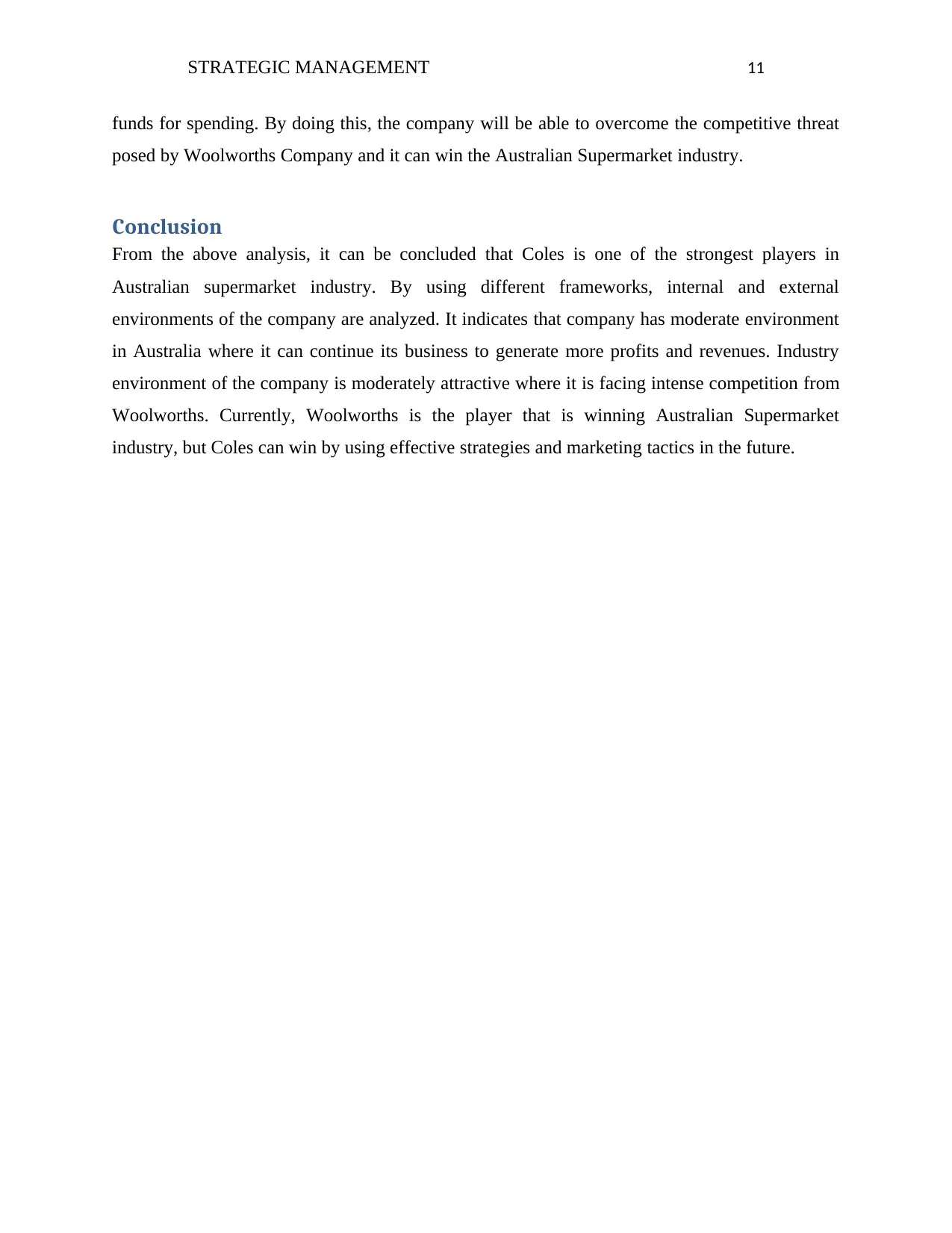
STRATEGIC MANAGEMENT 11
funds for spending. By doing this, the company will be able to overcome the competitive threat
posed by Woolworths Company and it can win the Australian Supermarket industry.
Conclusion
From the above analysis, it can be concluded that Coles is one of the strongest players in
Australian supermarket industry. By using different frameworks, internal and external
environments of the company are analyzed. It indicates that company has moderate environment
in Australia where it can continue its business to generate more profits and revenues. Industry
environment of the company is moderately attractive where it is facing intense competition from
Woolworths. Currently, Woolworths is the player that is winning Australian Supermarket
industry, but Coles can win by using effective strategies and marketing tactics in the future.
funds for spending. By doing this, the company will be able to overcome the competitive threat
posed by Woolworths Company and it can win the Australian Supermarket industry.
Conclusion
From the above analysis, it can be concluded that Coles is one of the strongest players in
Australian supermarket industry. By using different frameworks, internal and external
environments of the company are analyzed. It indicates that company has moderate environment
in Australia where it can continue its business to generate more profits and revenues. Industry
environment of the company is moderately attractive where it is facing intense competition from
Woolworths. Currently, Woolworths is the player that is winning Australian Supermarket
industry, but Coles can win by using effective strategies and marketing tactics in the future.

STRATEGIC MANAGEMENT 12
References
Chan, A.T., Ngai, E.W. and Moon, K.K., 2017. The effects of strategic and manufacturing
flexibilities and supply chain agility on firm performance in the fashion industry. European
Journal of Operational Research, 259(2), pp.486-499.
Clark, G., 2018, Research: Key challenges for retail sector unveiled, Available from
https://www.retailbiz.com.au/latest-news/research-key-challenges-for-retail-sector-unveiled/
[Accessed on 7 December 2018].
Coles, 2018, Coles Supermarkets, Available from https://www.coles.com.au/ [Accessed on 7
December 2018].
Cooper, R., 2018, Challenges and opportunities of retailing in 2018, Available from
https://www.retailbiz.com.au/topics/trends-research/challenges-opportunities-retailing-in-2018/
[Accessed on 7 December 2018].
Doz, Y.L., 2017. Strategic management in multinational companies. In International
Business (pp. 229-248). Routledge.
Dobbs, M., 2014, Guidelines for applying Porter's five forces framework: a set of industry
analysis templates. Competitiveness Review, 24(1), 32-45.
Hill, T., 2017. Manufacturing strategy: the strategic management of the manufacturing function.
Macmillan International Higher Education.
Keith, S., 2012, Coles, Woolworths and the local. Locale: The Australasian-Pacific Journal of
Regional Food Studies, 2, 47-81.
Knott, P. J., 2015, Does VRIO help managers evaluate a firm’s resources?. Management
Decision, 53(8), 1806-1822.
KPMG., 2018, Future of retail in Australia, Available from
https://home.kpmg.com/au/en/home/insights/2018/04/bernard-salt-next-5-years-retail-future-
australia.html [Accessed on 7 December 2018].
References
Chan, A.T., Ngai, E.W. and Moon, K.K., 2017. The effects of strategic and manufacturing
flexibilities and supply chain agility on firm performance in the fashion industry. European
Journal of Operational Research, 259(2), pp.486-499.
Clark, G., 2018, Research: Key challenges for retail sector unveiled, Available from
https://www.retailbiz.com.au/latest-news/research-key-challenges-for-retail-sector-unveiled/
[Accessed on 7 December 2018].
Coles, 2018, Coles Supermarkets, Available from https://www.coles.com.au/ [Accessed on 7
December 2018].
Cooper, R., 2018, Challenges and opportunities of retailing in 2018, Available from
https://www.retailbiz.com.au/topics/trends-research/challenges-opportunities-retailing-in-2018/
[Accessed on 7 December 2018].
Doz, Y.L., 2017. Strategic management in multinational companies. In International
Business (pp. 229-248). Routledge.
Dobbs, M., 2014, Guidelines for applying Porter's five forces framework: a set of industry
analysis templates. Competitiveness Review, 24(1), 32-45.
Hill, T., 2017. Manufacturing strategy: the strategic management of the manufacturing function.
Macmillan International Higher Education.
Keith, S., 2012, Coles, Woolworths and the local. Locale: The Australasian-Pacific Journal of
Regional Food Studies, 2, 47-81.
Knott, P. J., 2015, Does VRIO help managers evaluate a firm’s resources?. Management
Decision, 53(8), 1806-1822.
KPMG., 2018, Future of retail in Australia, Available from
https://home.kpmg.com/au/en/home/insights/2018/04/bernard-salt-next-5-years-retail-future-
australia.html [Accessed on 7 December 2018].
⊘ This is a preview!⊘
Do you want full access?
Subscribe today to unlock all pages.

Trusted by 1+ million students worldwide
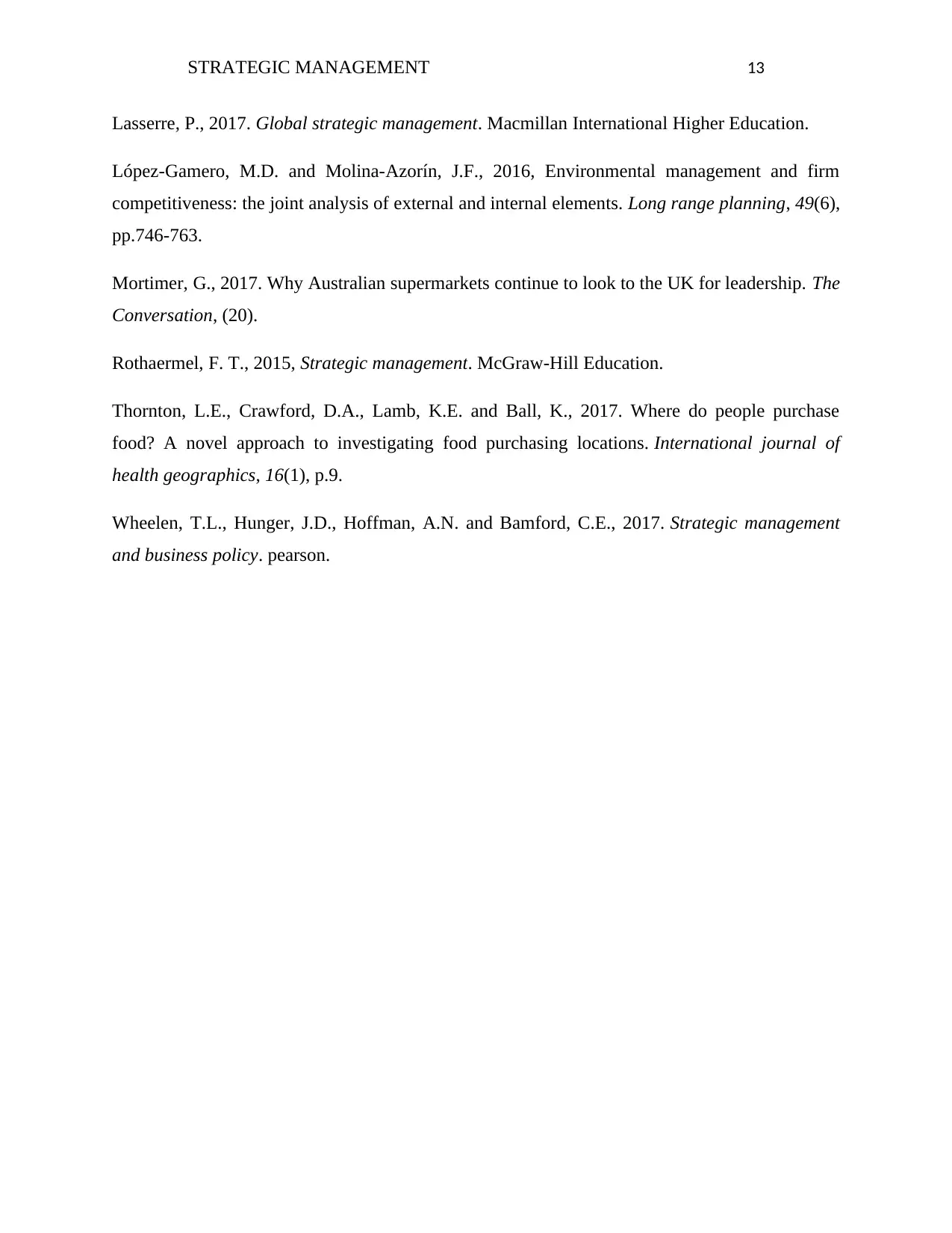
STRATEGIC MANAGEMENT 13
Lasserre, P., 2017. Global strategic management. Macmillan International Higher Education.
López-Gamero, M.D. and Molina-Azorín, J.F., 2016, Environmental management and firm
competitiveness: the joint analysis of external and internal elements. Long range planning, 49(6),
pp.746-763.
Mortimer, G., 2017. Why Australian supermarkets continue to look to the UK for leadership. The
Conversation, (20).
Rothaermel, F. T., 2015, Strategic management. McGraw-Hill Education.
Thornton, L.E., Crawford, D.A., Lamb, K.E. and Ball, K., 2017. Where do people purchase
food? A novel approach to investigating food purchasing locations. International journal of
health geographics, 16(1), p.9.
Wheelen, T.L., Hunger, J.D., Hoffman, A.N. and Bamford, C.E., 2017. Strategic management
and business policy. pearson.
Lasserre, P., 2017. Global strategic management. Macmillan International Higher Education.
López-Gamero, M.D. and Molina-Azorín, J.F., 2016, Environmental management and firm
competitiveness: the joint analysis of external and internal elements. Long range planning, 49(6),
pp.746-763.
Mortimer, G., 2017. Why Australian supermarkets continue to look to the UK for leadership. The
Conversation, (20).
Rothaermel, F. T., 2015, Strategic management. McGraw-Hill Education.
Thornton, L.E., Crawford, D.A., Lamb, K.E. and Ball, K., 2017. Where do people purchase
food? A novel approach to investigating food purchasing locations. International journal of
health geographics, 16(1), p.9.
Wheelen, T.L., Hunger, J.D., Hoffman, A.N. and Bamford, C.E., 2017. Strategic management
and business policy. pearson.
Paraphrase This Document
Need a fresh take? Get an instant paraphrase of this document with our AI Paraphraser
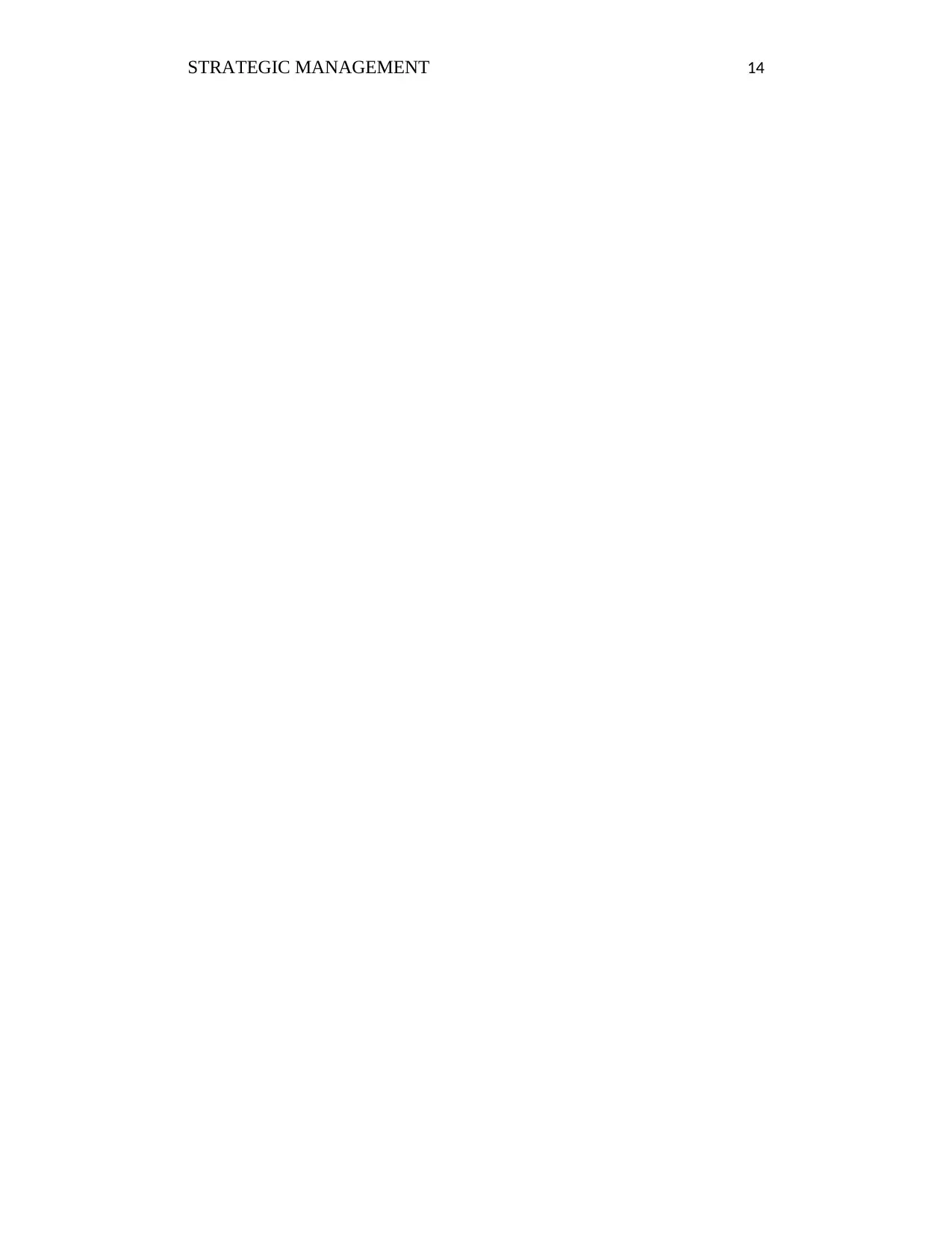
STRATEGIC MANAGEMENT 14
1 out of 14